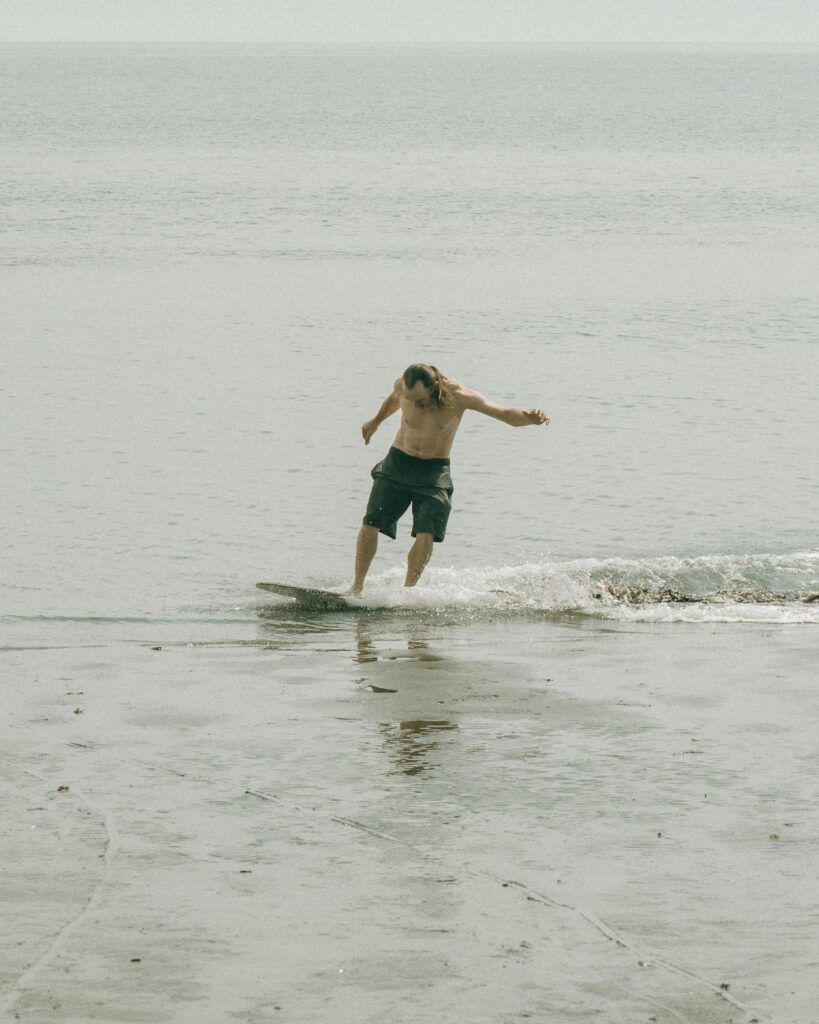Tamarindo, a hidden gem nestled on Costa Rica’s Pacific Coast, offers pristine sandy beaches and perfect waves for beginners eager to catch their first wave. In this beginner’s guide to surfing in Tamarindo, you will discover the essential tips and tricks to ride the waves like a pro, even if you’re a complete novice. From choosing the right board to mastering proper surfing techniques, this guide will equip you with all the knowledge and confidence you need to embark on an unforgettable surfing adventure in Tamarindo. So grab your board and get ready to experience the thrill of catching the perfect wave in this tropical paradise.

Understanding Tamarindo’s Surf Scene
Tamarindo, a vibrant coastal town located on the Pacific coast of Costa Rica, is renowned for its incredible surf scene. With its consistent waves, warm waters, and beautiful beaches, Tamarindo attracts surfers from all around the world. The town features a thriving surfing culture that blends local traditions with the international surfing community, creating a unique and welcoming atmosphere for surfers of all levels.
Overview of Tamarindo’s Surfing Culture
Tamarindo’s surfing culture is deeply ingrained in the fabric of the town. Surfers fill the beaches from sunrise to sunset, embracing the laid-back lifestyle and the exhilarating rush of riding waves. The locals are passionate about surfing and are always ready to share their knowledge and love for the sport. From surf shops to surf schools, Tamarindo provides ample opportunities to immerse yourself in the vibrant surf culture and make lasting memories.
Dominant Surf Seasons in Tamarindo
Tamarindo experiences two dominant surf seasons, each offering a unique surfing experience. The summer season, from May to November, brings larger swells, providing excellent conditions for advanced and experienced surfers. The winter season, from December to April, sees smaller and more manageable waves, making it an ideal time for beginners and intermediate surfers to test their skills. Regardless of the season, Tamarindo offers consistent waves and warm water year-round, ensuring an unforgettable surf trip.
Popular Surfing Spots and Their Distinct Characteristics
Tamarindo boasts an array of stunning surfing spots, each with its own distinct characteristics. Playa Tamarindo, the town’s main beach, offers a variety of waves suitable for surfers of all levels. The rivermouth break provides easy beach breaks, making it an ideal spot for beginners to catch their first waves. For more experienced surfers, Playa Langosta, located to the south of Tamarindo, offers powerful waves and challenging reef breaks. Other popular spots, such as Playa Grande and Avellanas, are just a short drive away, adding more diversity to Tamarindo’s surf scene.
Preparing for Your Surfing Trip to Tamarindo
Before embarking on your surfing adventure in Tamarindo, it’s essential to prepare yourself adequately. From the right equipment to safety gear, ensuring you have everything you need will contribute to a successful and enjoyable surf experience.
Equipment Needed for Surfing
The basic equipment needed for surfing includes a surfboard, leash, wax, and fins. Choosing the right surfboard for your skill level and the wave conditions in Tamarindo is crucial. More on that later. Additionally, a rash guard or wetsuit is recommended to protect your skin from the sun and potential scrapes. Sunscreen, a towel, and a hat are also necessary to protect yourself from the tropical sun.
Safety Gear Necessary for Beginners
For beginners, safety should be a top priority. Investing in a well-fitting and comfortable surf helmet is highly recommended, as it can protect you from head injuries caused by falls or collisions. Additionally, wearing earplugs can prevent surfers’ ear, a condition caused by prolonged exposure to cold water and strong waves. Lastly, a trusty first aid kit should be on hand to tend to minor injuries that may occur during your surf sessions.
Surfboard Rental Options in Tamarindo
If you’re traveling light or don’t have your own surfboard, fret not! Tamarindo has an abundance of surfboard rental options available. Numerous surf shops and rental outlets offer a wide range of surfboards suited to different skill levels and wave conditions. From soft-top beginner boards to high-performance shortboards, you can find the perfect board to accompany you on your Tamarindo surf adventure.
Packing List Specific for Tamarindo’s Climate
When packing for your Tamarindo surf trip, take into account the region’s tropical climate. Lightweight and breathable clothing, such as board shorts, tank tops, and sundresses, are essential to stay comfortable in the heat. Don’t forget to pack a pair of durable flip-flops or sandals for walking on the sandy beaches. Additionally, insect repellent, sunglasses, and a reusable water bottle are must-haves to protect against pesky bugs, harsh sun rays, and to stay hydrated throughout the day.
Choosing the Perfect Surfboard for Beginners
As a beginner surfer gearing up for your Tamarindo adventure, selecting the right surfboard is key to developing your skills and enjoying the experience to the fullest.
Discussing Different Types of Surfboards
Surfboards come in various shapes, sizes, and materials, each designed for specific types of waves and skill levels. The three main types of surfboards commonly used are longboards, funboards, and shortboards. Longboards are great for beginners as they offer stability and easy wave-catching capabilities. Funboards, as the name suggests, provide a balance between longboards and shortboards, offering maneuverability and stability. Shortboards, on the other hand, are more suited for advanced surfers and are designed for high-performance maneuvers on powerful waves.
Best Beginner-Friendly Surfboards
For beginners, longboards and funboards are the most suitable options. Longboards, with their generous volume and stability, are perfect for learning the basics of paddling, balance, and wave-catching. Funboards, which are slightly shorter and more maneuverable than longboards, provide a smooth transition from longboarding to more advanced surfing techniques. Foam boards, or soft-top boards, are also highly recommended for beginners due to their forgiving nature and buoyancy.
Renting vs Buying a Surfboard
If you’re new to surfing, renting a surfboard is a practical and cost-effective option. Renting allows you to try out different types of surfboards and figure out what works best for you before committing to a purchase. On the other hand, if you plan to pursue surfing as a long-term hobby, investing in your own surfboard can provide a sense of ownership and allow for more personalized customization. Owning a surfboard also gives you the freedom to surf whenever the waves beckon, without having to rely on rental availability.
Basic Surfing Lessons
As a beginner surfer in Tamarindo, it is highly recommended to take basic surfing lessons to kickstart your surfing journey and ensure a solid foundation.
Proper Stance Techniques
Learning the proper stance technique is fundamental to successful surfing. Start by practicing your balance on the surfboard on the sand, ensuring your feet are parallel to each other and shoulder-width apart. As you move into the water, remember to keep your weight slightly forward, with your knees bent and your arms out for balance. Finding the right stance will help you maintain control and maneuverability on the waves.
Mastering Paddle-Out Techniques
Paddling out to the lineup can often be challenging, especially for beginners. It’s essential to observe the waves and time your paddle-outs between sets to minimize the effort required. Paddle smoothly and efficiently, using long and powerful strokes, to conserve energy. It’s also important to be aware of other surfers and their positions, practicing good surf etiquette and avoiding collisions.
Catching Your First Wave Successfully
One of the most exhilarating moments for a beginner surfer is catching their first wave. Start by selecting an appropriate beginner-friendly wave that is not too powerful or steep. As the wave approaches, paddle with strong and steady strokes to match its speed. Once you feel the wave propelling you forward, pop up onto your feet, bringing your knees under your chest in a crouched position. Maintain balance and ride the wave, enjoying the feeling of gliding along the water’s surface.

Hiring a Surf Instructor in Tamarindo
While learning to surf can be a thrilling and rewarding experience, having a knowledgeable and experienced surf instructor by your side can greatly enhance your progress and ensure your safety.
Benefits of Hiring a Local Surf Instructor
Hiring a local surf instructor in Tamarindo offers several advantages. Local instructors possess an intimate knowledge of the area’s surf breaks, wave conditions, and the best times to surf. They can guide you to the most suitable spots for your skill level, minimizing frustration and maximizing your enjoyment. Additionally, they provide valuable insight into local surf culture and etiquette, ensuring that you surf respectfully and responsibly.
Tips to Select a Reputable Surf Instructor
When selecting a surf instructor, it’s crucial to consider their qualifications, experience, and teaching style. Look for instructors who are certified by reputable surf organizations and have a strong track record of teaching beginner surfers. A good instructor should be patient, supportive, and capable of adapting their teaching methods to suit individual learning styles. Reading online reviews and consulting with local surf shops can also provide valuable insights into the reputation and quality of different surf instructors in Tamarindo.
Costs Associated with Hiring a Surf Instructor
The cost of hiring a surf instructor in Tamarindo can vary depending on various factors such as lesson duration, group size, and the reputation of the instructor. Private lessons generally cost more than group lessons, but they offer personalized attention and faster progress. It’s advisable to inquire about prices and compare different surf schools or instructors to find the best value for your budget. Keep in mind that investing in a qualified and experienced instructor is an investment in your safety and the quality of your surf experience.
Respecting Surf Etiquette
Tamarindo, like any other surfing destination, has its own set of surf etiquette that should be followed to ensure a harmonious and enjoyable experience for everyone in the water.
Review of Standard Surfing Rules
Understanding and following standard surfing rules is crucial to avoid accidents and conflicts in the lineup. Some essential rules to keep in mind include:
- Give right of way to the surfer closest to the peak of the wave.
- Avoid dropping in or taking off on a wave that another surfer is already riding.
- Paddle wide around surfers to avoid collisions.
- Share waves and practice patience, ensuring that everyone gets their fair share of rides.
- Be respectful and courteous to other surfers, regardless of their skill level.
Importance of Respecting Local Surf Culture
Respecting and embracing the local surf culture in Tamarindo is a vital aspect of being a conscientious surfer. Take the time to learn about the local customs, norms, and traditions associated with surfing in the town. Engage in conversations with locals, show respect for the beach environment, and support local businesses such as surf shops and eateries. By immersing yourself in the local surf culture, you’ll gain a deeper appreciation for the community and its connection to the ocean.
Avoiding Typical Beginner Surfing Mistakes
As a beginner surfer, it’s natural to make mistakes while learning the ropes. However, being aware of common beginner mistakes can help you avoid them and progress more effectively. Some common mistakes to watch out for include:
- Catching waves that are too large and powerful for your skill level.
- Not observing proper surf etiquette and causing disruptions or accidents in the lineup.
- Using improper paddling techniques, leading to exhaustion and limited wave-catching ability.
- Neglecting to warm up and stretch before surfing, increasing the risk of injuries.
- Failing to read and understand surf reports and wave conditions, leading to suboptimal surfing conditions.

Navigating Tamarindo’s Wave Conditions
Understanding the wave conditions in Tamarindo is essential for maximizing your surf sessions and ensuring your safety in the water.
Understanding Wave Size and Styles in Tamarindo
Tamarindo offers a range of wave sizes and styles depending on the surf break and the prevailing wave conditions. Wave size can vary from small and mellow waves suitable for beginners, to larger and more powerful waves that challenge experienced surfers. Different breaks and tides can also influence wave styles, ranging from gentle and rolling waves to more hollow and fast-breaking waves. Familiarizing yourself with the local wave size and styles will help you choose appropriate breaks and improve your wave selection skills.
How to Read Surf Reports
Surf reports are an invaluable tool for surfers looking to make the most out of their sessions. In Tamarindo, several websites and mobile applications provide detailed surf reports that include information on wave height, swell direction, wind conditions, and tide charts. Understanding how to interpret surf reports will allow you to plan your surf sessions based on the optimal wave conditions for your skill level. Consulting surf reports before heading out on the water can save you time and ensure a more enjoyable surfing experience.
Tips for Handling Rip Currents
Rip currents are powerful, narrow currents of water that flow swiftly away from the shore. They can be dangerous, especially for inexperienced surfers. In Tamarindo, it’s important to be aware of rip currents and know how to handle them if caught in one. The best approach is to remain calm, conserve energy, and avoid fighting against the current. Swim parallel to the shore until you’re out of the rip and then swim back to the shore diagonally. If you’re uncertain about dealing with rip currents, it’s advisable to consult a local surf instructor or lifeguard for guidance.
Keeping Safe as a Beginner Surfer in Tamarindo
As with any physical activity, safety should be a top priority when engaging in surfing. Taking precautions and adopting safety measures will ensure a positive and injury-free surf experience.
Importance of Warm-up and Stretches before Surfing
Before hitting the waves, it’s crucial to warm up your body and stretch your muscles to prevent injuries. Engaging in dynamic warm-up exercises, such as jogging or jumping jacks, increases blood flow and prepares your body for the physical demands of surfing. Incorporating stretches that target the shoulders, back, hips, and legs will enhance flexibility and reduce the risk of strains or sprains. A warm-up routine will also help you get in the right mindset for a focused and enjoyable surf session.
Risks and Injuries Commonly Associated with Surfing
While surfing is an exhilarating and relatively safe sport, certain risks and injuries are associated with it. Common injuries include cuts, bruises, sprains, strains, and dislocations. Surfers may also experience surf-related ailments such as surfers’ ear, which is the thickening of the ear canal due to cold water exposure and strong waves. It’s crucial to be aware of these risks and take preventative measures, such as wearing protective gear and listening to your body’s limits, to minimize the likelihood of injury.
First-Aid Essentials for Surfing Incidents
Having a basic first aid kit on hand is essential for addressing minor injuries that may occur while surfing. The kit should include adhesive bandages, antiseptic wipes, gauze pads, adhesive tape, and an instant cold pack. Familiarize yourself with basic first aid procedures, such as cleaning wounds and immobilizing injured joints, to effectively respond to surfing incidents. Additionally, it’s recommended to learn CPR and other life-saving techniques as an added safety precaution for yourself and fellow surfers.

Expanding Your Surfing Skills
Once you’ve mastered the basics of surfing, you may find yourself craving new challenges and opportunities to push your skills to the next level. Tamarindo offers several avenues for expanding your surfing skills and experiencing the sport in a more advanced and thrilling manner.
Advanced Surfing Maneuvers
As you progress as a surfer, you can start experimenting with more advanced maneuvers and techniques. Carving turns, cutbacks, bottom turns, and floaters are some examples of maneuvers that can add flair and style to your surfing. It’s essential to practice these maneuvers in controlled conditions and gradually increase the difficulty as you gain confidence and skill. Observing experienced surfers and seeking advice from local instructors can provide valuable insights into executing these maneuvers effectively.
Participating in Local Surf Events or Competitions
Immersing yourself in the local surfing community by participating in surf events or competitions can be a transformative experience. Tamarindo hosts various surf competitions and events throughout the year, offering a platform for surfers of all levels to showcase their skills and interact with like-minded individuals. Participating in these events can boost your motivation, allow you to meet fellow surfers, and provide valuable feedback from judges and experienced surfers.
Useful Off-Water Training for Surfing
Improving your surfing skills extends beyond the water. Engaging in off-water training exercises that target your overall fitness, strength, and flexibility can greatly enhance your performance in the water. Cardiovascular exercises, such as swimming or running, can improve endurance, while strength training exercises, such as squats and lunges, can enhance stability and power. Incorporating yoga or Pilates into your routine can improve balance, flexibility, and body awareness. A well-rounded off-water training regimen will complement your surfing skills and contribute to your overall progression as a surfer.
Surviving Post-Surf Muscle Soreness
After an epic surf session in Tamarindo, it’s common to experience muscle soreness and fatigue. Taking care of your body post-surf will help expedite the recovery process and ensure that you’re ready for more waves the next day.
Dealing with Common Post-Surf Strains
Muscle soreness, strains, and stiffness are common after intense physical activity like surfing. Applying ice or cold packs to sore muscles can help reduce inflammation and alleviate pain. Gentle stretching and foam rolling can also assist in relieving tension and promoting blood flow to the muscles. It’s important to listen to your body and give yourself adequate rest and recovery time between surf sessions, allowing your muscles to heal and rebuild.
Proper Post-Surf Nutrition
Fueling your body with the right nutrients post-surf is crucial for recovery and replenishment. Consuming a well-balanced meal that includes lean proteins, carbohydrates, and healthy fats will aid in muscle repair and replenish glycogen stores. Hydrating properly with water and electrolyte-rich beverages will help rehydrate your body and restore electrolyte balance. Additionally, incorporating anti-inflammatory foods such as fruits, vegetables, and omega-3 fatty acids can aid in reducing post-surf inflammation and soreness.
Exercises to Alleviate Muscle Soreness
Incorporating light and gentle exercises into your routine can help alleviate muscle soreness and stiffness post-surf. Low-impact activities such as swimming, biking, or gentle yoga can promote blood circulation and aid in flushing out built-up lactic acid. Additionally, engaging in dynamic stretching exercises that target sore muscles can help increase flexibility and decrease muscle tightness. A combination of rest, proper nutrition, and light exercise will facilitate a quicker recovery and ensure that you’re ready for your next surf session in Tamarindo.
By thoroughly understanding Tamarindo’s surf scene, preparing effectively for your surfing trip, acquiring the necessary skills through lessons, respecting the local surf culture, and ensuring your safety at all times, you are well on your way to enjoying an unforgettable surfing experience in this tropical paradise. Embrace the waves, soak up the sun, and savor every moment as you ride the waves in one of Costa Rica’s premier surf destinations.








0 Comments